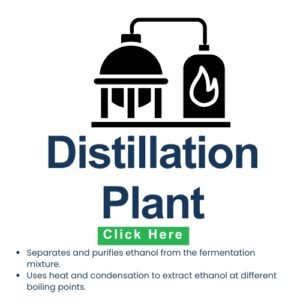Discover the working of a Distillation Plant in ethanol production with essential formulas, mass balance equations, reflux ratio, and efficiency calculations for maximum ethanol purity.
Table of Contents

Introduction
Distillation Plant is a crucial part of ethanol production, where ethanol is separated from the fermented mash using differences in boiling points. Through controlled heating, vaporization, and condensation, this process removes water and impurities to achieve high-purity ethanol.
As a widely used industrial method, distillation follows specific equations and principles to maximize efficiency. Understanding its working, key formulas, and calculations is essential for optimizing ethanol recovery in production.
1. Working of a Distillation Plant
The distillation process in ethanol production involves the following key steps:
- Feed Introduction – The fermented mash (beer) containing ethanol and water is fed into the distillation column.
- Heating & Vaporization – Heat is applied, and ethanol, with a lower boiling point than water (78.3°C vs. 100°C), starts to evaporate.
- Separation & Fractionation – The rising ethanol vapor passes through trays and packing materials, enriching its purity.
- Condensation – The ethanol vapor is cooled down and converted back into liquid form in a condenser.
- Collection of Distillate – The purified ethanol is collected as the final product, while the residue (bottoms) is removed separately.
- Reflux System – A portion of the distillate is returned to the column to improve ethanol concentration.
2. Key Equations & Industrial Calculations : conversions-calculators
Basic Distillation Equation:
Feed = Distillate + Bottoms
F = D + B
Where:
- F = Feed (incoming fermented mash)
- D = Distillate (purified ethanol)
- B = Bottoms (leftover residue)
Ethanol Purity Calculation:
Ethanol Purity (%) = (Ethanol in Distillate / Total Distillate) × 100
Example Calculation:
If 950 liters of ethanol is obtained from 1000 liters of distillate:
(950 / 1000) × 100 = 95% ethanol purity
Mass Balance Equation for Distillation Column:
F × xf = D × xd + B × xb
Where:
- xf = Ethanol fraction in feed
- xd = Ethanol fraction in distillate
- xb = Ethanol fraction in bottoms
Relative Volatility (α) for Ethanol-Water System:
α = (y/x) / ((1 - y) / (1 - x))
Where:
- y = Mole fraction of ethanol in vapor phase
- x = Mole fraction of ethanol in liquid phase
Reflux Ratio (R) Calculation:
R = L/D
Where:
- L = Liquid returned to the column
- D = Distillate collected
Example: If 150 liters is returned and 50 liters is collected:
R = 150 / 50 = 3
(Reflux ratio = 3:1)
Energy Requirement Calculation:
Q = m × Cp × ΔT
Where:
- Q = Heat required (kJ)
- m = Mass of liquid (kg)
- Cp = Specific heat capacity (kJ/kg·K)
- ΔT = Temperature change (°C)
3. Importance of Reflux Ratio in Ethanol Purification
The Reflux Ratio (R) is a crucial factor in ethanol distillation. A higher reflux ratio increases ethanol purity but also raises energy consumption. In industrial ethanol production, a balance between efficiency and cost is maintained by optimizing the reflux ratio.
Typical Industrial Reflux Ratios:
- Low Purity Ethanol (50-70%) → R = 2-3
- Fuel-Grade Ethanol (95-99%) → R = 4-6
- Pharmaceutical-Grade Ethanol (99.9%) → R = 6-10
4. Efficiency Factors in Distillation
Several factors influence the efficiency of an ethanol distillation plant:
- Feed Composition – Higher ethanol content in the feed improves recovery rates.
- Column Design – Packed columns provide better separation efficiency than tray columns.
- Temperature Control – Precise heat control prevents loss of ethanol.
- Vacuum Distillation – Reduces boiling temperature, saving energy.
- Reflux Optimization – Balancing purity and cost.
5. Real-World Example: Ethanol Recovery from 1000 kg of Fermented Mash
Given:
- Ethanol concentration in mash = 10%
- Efficiency of distillation = 90%
- Theoretical ethanol yield = 0.511 kg ethanol per kg of glucose
Step 1: Calculate Theoretical Yield
1000 × 0.511 = 511 kg of ethanol
Step 2: Adjust for 90% Efficiency
511 × 0.90 = 460 kg of ethanol recovered
Thus, from 1000 kg of fermented mash, we obtain 460 kg of ethanol under industrial conditions.
These links provide authoritative insights on ethanol distillation, efficiency optimization, and industry standards. Let me know if you need specific references!
- Ethanol Production Process Overview – U.S. Department of Energy
- Distillation Principles & Techniques – ScienceDirect
- Reflux Ratio & Column Efficiency – American Chemical Society (ACS)
- Industrial Ethanol Distillation Technologies – ResearchGate
- Ethanol Fuel Standards & Regulations – Renewable Fuels Association
6. FAQs About Distillation in Ethanol Production
Q1: What is the main purpose of distillation in ethanol production?
Distillation is used to separate and purify ethanol from the fermented mixture based on its boiling point.
Q2: How does the reflux ratio impact ethanol purity?
A higher reflux ratio increases ethanol purity but also increases energy consumption. It must be optimized for cost-effectiveness.
Q3: What is the typical purity of ethanol obtained after distillation?
Standard distillation produces 95-96% ethanol. Further dehydration is needed for 99.9% fuel-grade ethanol.
Q4: Why is vacuum distillation used in some ethanol plants?
Vacuum distillation lowers the boiling point, reducing energy consumption and preventing thermal degradation.
Q5: Can distillation be used for bioethanol production?
Yes, distillation is a critical step in bioethanol production, ensuring high-purity ethanol for fuel and industrial use.
Distillation Plant is the core unit of ethanol production, ensuring high-purity ethanol recovery through advanced separation techniques. By optimizing factors such as reflux ratio, feed composition, and energy consumption, industries can achieve maximum efficiency and cost-effectiveness.
For the latest ethanol industry updates, visit: ethanolnews.in
Read More:





